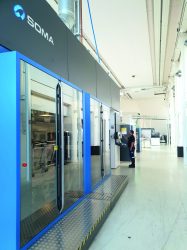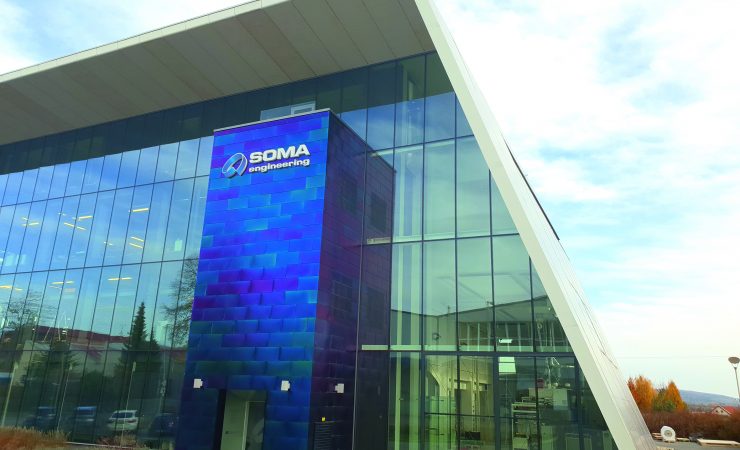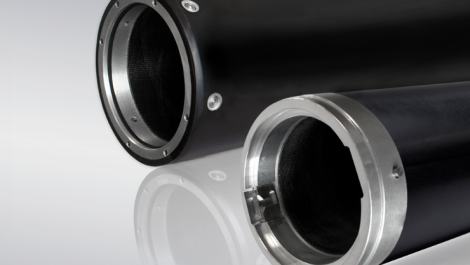While some companies look to offer more affordable alternatives, Soma has no such intention, preferring to focus on high quality machinery, with features to tackle some of the biggest problems facing flexible packaging printers. Michal Lodej went to learn more.
Based in Lanskroun, Czech Republic, Soma’s story begins shortly after the fall of the Iron Curtain, when countries in Central and Eastern Europe freed themselves from the oppression of the Soviet Union. As the shackles of communism were thrown off, many factories that were once state owned, became available for entrepreneurs to privatise and run competitively. Soma was privatised in 1992, and at first made bespoke machinery on request, however, management wanted to create a machine of their own, one that they could develop, improve and pour their own talent and culture into. With knowledge of building converting machinery, the company embarked on building its own flexo press which was launched in 1995.
The machine evolved, with a new generation released every single year, until in 2008 when the company launched the Flexo Imperia 10-colour press, a machine which created a new bench mark for Soma. However it was in 2013 that the company’s designers found a way to really set themselves apart from the competition with the launch of the Optima press, and then again at drupa 2016 with the launch of the Optima II press. Petr Blasko, marketing manager, explained, ‘We wanted to set ourselves apart from the competition in the market, so we looked at what were the main issues for printers running CI presses.’
The three main problems they identified were bouncing when running at high speeds, consistency throughout the print run, and the continual rise of short runs. To tackle bouncing the Optima II comes with Advance Bounce Control, which is made possible by many different features working together to stabilise the press.
A major part of this is the press’ construction which is built from a single cast iron block frame up to 260mm at its thickest point. Other parts also play a role, such as the locking mechanism for printing cylinders. These lock into place by sliding into position, but only move along one axis of direction, adding an extra element of stability.

Customers can use the company’s demo room to trial different materials
The press also uses thermal stabilisation for the print decks by using water to cool the press, keeping it at a constant temperature to prevent parts expanding from the heat, which could have a drastic effect on the performance of a press.
While bounce control allows printing at full speed without bounce related issues, it also allows the press to reach consistent impression needed for perfect registration. This eliminated the second issue facing many CI flexo press printers; consistency. The press is stable, so the dots are stable which means pre-press can safely know how to calculate the accuracy of the press.
Another strategy to make the press run more consistent was to implement the Arun system from Allstein. Arun is an intuitive and fully automatic function for impression and register setting which ensures the press is set up correctly.
The system also leads to solving the third big problem, short runs. Arun requires minimum effort from the operator as it is fully automatic and according to the company can set up for a print run with zero meters of waste.
Soma did not stop once the three main problems were addressed. The company’s desire to be high tech has lead to some interesting features on the Optima II. Mr Blasko explained, ‘Some suppliers are often looking to provide more affordable printing options for the market but we are not interested in devaluing any part of our brand and are constantly looking at ways which can make our presses more hi-tech.’
As with many presses available today, the Optima II is controlled with a touch screen. Ink Storm measures solvent and pressurised air consumption used to clean the press between jobs. It helps the operator to know how much is being used in an effort to control the usage of these expensive consumables. Above that, everything about the press is monitored and measured by the Press Monitoring System, to help printers understand all their outgoings and the time each part of the process takes. This helps printers to control consumption and efficiency of the press and can be view remotely on a smartphone or tablet.
In general to start a job, it could take six to eight litres of ink in one ink pumping loop before you have a sellable product. But with this press and Soma’s ink cartridge feature for very short runs or for using expensive inks, only need minimum one and maximum three litres. The unit is self-contained with its own viscosity control, mixing and is attached directly onto the doctor blade chamber. So during wash-up there are minimum leftovers, since there are no hoses or pipes involved in transferring an ink.
It is not all about the functionality of a press but the way it is designed too which is important, and the Optima II is certainly ‘a looker’. The printing decks are behind a glass bi-folding door, the type of which is popular with modern restaurants and homes to create that ‘indoor/outdoor living space’. The company’s founder, Ladislav Verner, started his career as a designer and so design is in the company’s DNA.
The press offers easy access to the web which according to the company customers love, and the printing control area has been designed to be as simple as possible. Ease for the operator is again taken into account by placing the controls on an arm which can swing around to the print checking area.
Production of the machines all takes place in house, which allows the company to control the quality of the machines it builds and the modular design means that the press can be built to the customers’ specification depending on which applications they run.
Customers can try out the machine to see which customisations they may want for themselves. Mr Blasko added, ‘We try to give our customers support and service from the first moment. For potential customers thinking of purchasing a press, they can send specific material and inks over to our demo suit here, they then can bring their own plates, so they can replicate their own print room as closely as possible and test the machines with them using live jobs.’
So what’s next for Soma? Pavla Kusa, commercial director and daughter of the company founder, explained, ‘The last five years have seen some rapid growth from us after we launched the first model of the Optima designed for mid-web segment. We set a trend, and we have since sold over 70 machines. The main issue for the wide web Optima was to answer the issue of bouncing. R&D had to change their mindset about how to manufacture the machinery and so we sat down with customers to find out what they really needed.’
She continued, ‘Every customer we have already has a need to sell short run work. We needed a press which could do both as we will always have customers whose main work is long run jobs but they will have the occasional short runs from the same customers at times and will take a hit and lose money on these because they want to keep the customer happy. We had to find a way of making these jobs profitable.’
So what’s next for the Czech manufacturer? ‘Penetration of the market and to keep the drive in innovation,’ said Mrs Kusa. ‘We are always thinking about new ways to improve the process and to answer our customer’s questions; we want to be a high tech company. It is about proving that we are a good choice of partner so that’s what we have to do next. We are a family company, my father knew of the importance of a personal responsibility for each customer and we feel a moral obligation about those companies; you don’t get that at other suppliers. Hard work is in our blood we must continue to be better.’






